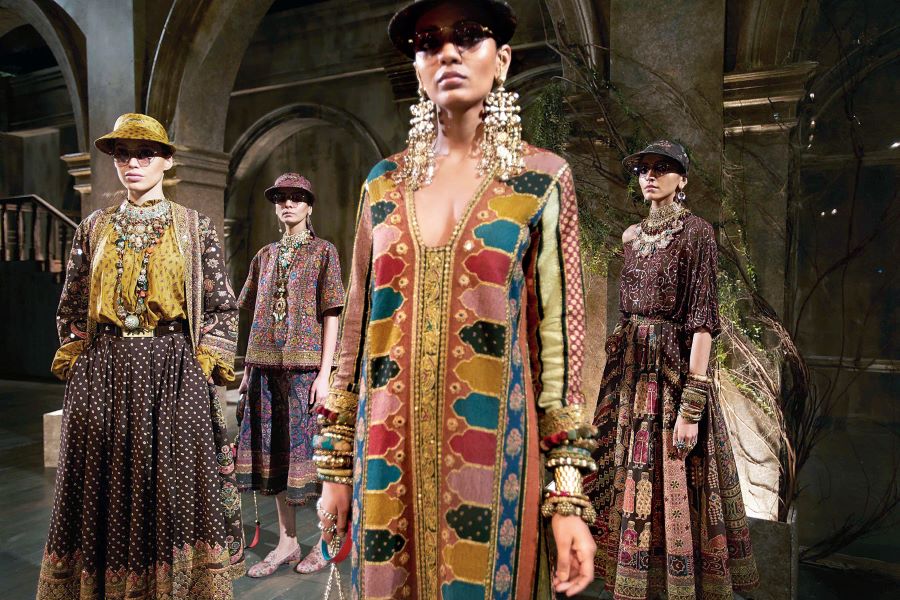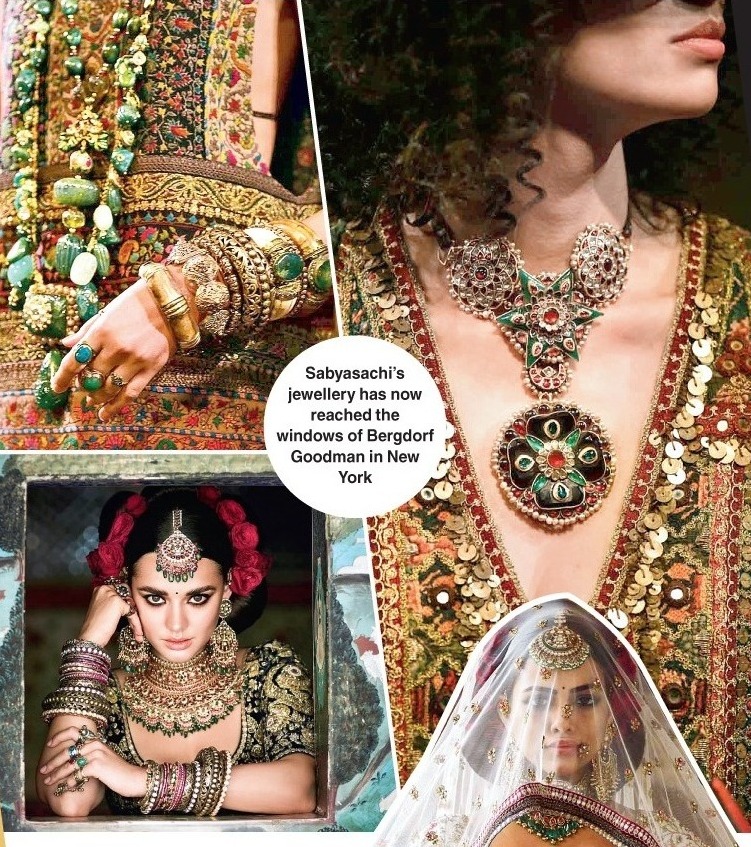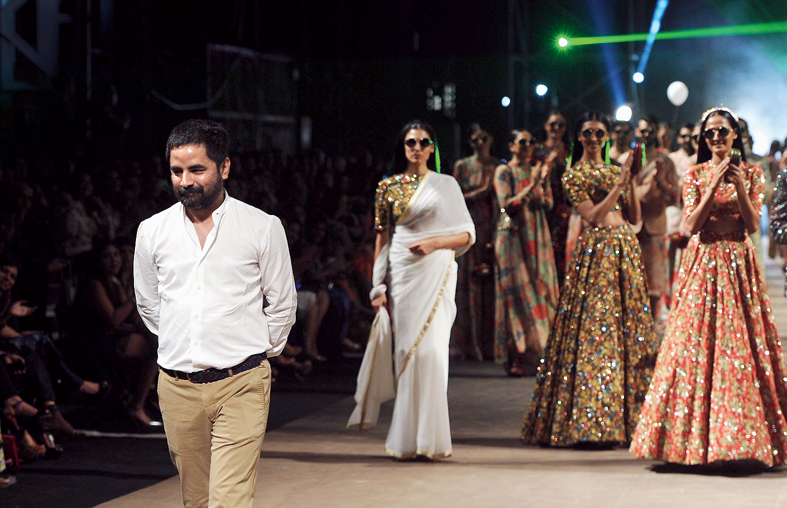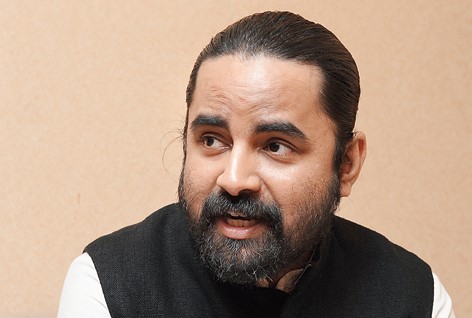Sabyasachi Mukherjee is not a man of few words. And, when he speaks, you listen. You are inspired. A shining example of self-made, Sabya, as he has been adorably monikered by his fashion fraternity, owns his name to a T. A lesson in dexterity — a creative genius matched by a keen sense of business — Sabyasachi oozes the dignity of making it to the top, never underplaying his craft. A quintessential ghee-bhaat loving Bengali, he is also your atypical Bengali. Bold. His world view makes him a philosopher and his quick wit, a teenager at soul.
“Right now, I’ll tell you my hands are very sweaty because I have done many webinars but I have suddenly realised that this was like a party that I have tried to avoid for 20 years… I get to see everybody here. I have never been this social in my life. So, hello everyone in Calcutta,” were his opening lines at an 85 Lansdowne live exclusive, The Future of Luxury Business, on a Zoom call one June afternoon, where he was in conversation with Priya Tanna of Vogue. Excerpts….
I have always thought that luxury for all of us has always been time...
My idea of luxury hasn’t changed during the pandemic. I have always thought that luxury for all of us has always been time. In a world which is completely guided by capitalism and when we are all chasing money… sometimes we don’t really know what to do with that money because there are two ways of looking at luxury — material luxury, which is the clothes that you wear, the make-up that you put on and the handbags that you use; but the main luxury is the dialogue and the conversation that you have with yourself. Fifteen years ago when I was in Goa, a friend asked me if I wanted to do a course in vipassana. I didn’t know what vipassana was. So, they explained to me that vipassana was all about remaining silent so that you disconnect the external world and have conversations with yourself. And, I do this every single day of my life because when I come back home, I don’t watch television, I don’t listen to music, I don’t talk to people… I just sit quietly and talk to myself… or I just stay with myself for 45 minutes because that’s my way of rebooting. For me, if I wasn’t given that time, I think a bigger part of my life’s luxury would have been taken out and I would end up becoming cranky.
For me, luxury is being able to have the time to be the best version of yourself and everything else would follow. I have always said that fashion and beauty have an important role to play in people’s manifestation of themselves. The first manifestation is about confidence and confidence comes from being who you are. You can only be yourself if you have the luxury of time to spend some time with yourself to understand who you are.
Frida Kahlo always led her life the way she wanted to...
She has always been my muse because of the fact that she was body-confident, culturally confident... she always led her life the way she wanted to lead her life. She was confident about her beauty and celebrated her unibrow and took every adversity and made that into a positive resource. And, when people lead that kind of a life which is so holistic and manage to influence people... these are people who are leading true lives of luxury. I don’t think for me luxury is a price barometer. It’s a lifestyle and cultural capital barometer.

A moment from Sabyasachi’s 20 years celebratory show in Mumbai last year Courtesy: Sabyasachi
I will make my craft stronger and stronger...
The only kind of work you can do right now is work that has demand. I am not only talking about fashion, but every industry. The greatest indignity that can happen to any businessman is not to have the means or the financial resources to be able to look after the people who have created a ecosystem for many many years. The best thing to do right now would be to create a little bit of work for weavers for a new season. That season does not have to be an immediate season... because in the immediate season we see no recovery... but to be able to give them some sort of a work from your savings that can be adopted into a new season, which I would probably think is spring/summer ’21. And also this is the time to be able to hold craft at its highest level because a big fallout of any recession, any pandemic... whenever there is big loss of finance in the world, there are two kinds of consumption — some people are going to become very mindful of what they consume and some people are going to become outrageous about what they consume because a lot of people will try to hide the anxiety of losing money and it will be a defence mechanism. We saw that happening with Dior with the new look. In one kind of consumption, the product will become very simple and in the other, the product will sustain at its highest level and I will choose to do this second part of the consumption where I will make my craft stronger and stronger so that I can keep people at their jobs because when your market share decreases, what will automatically happen is that people will not stop shopping, but they will stop shopping for things which is about time-bound products and they are going to be smarter about the consumption. They are going to consume less, but they will consume the best.
This is the best time for craft consolidation. So, instead of making 500 saris because I might not have 500 customers, I will probably create only 20 saris that will take the same time. This is the time to make saris like patan patolas because these cannot be made in larger quantities but can be made for people who will have the money to shop post the pandemic.
Let’s talk about a favourite topic of mine... nepotism. It exists in the jewellery industry...
For the longest time, jewellery has had a very strange relationship with India. I was in Bergdorf Goodman and meeting the head buyers... they came to India and fell in love with my jewellery and wanted to put it in the Bergdorf windows... I have been in the clothing industry for 20 years, my clothes didn’t make the cut because when Linda Fargo (of Bergdorf Goodman) came to India, she came with the idea of taking me to Bergdorf. She didn’t know what she wanted out of me and then she saw the jewellery and she said ‘my customers in America will love your jewellery’. We took the jewellery there and the first question I asked her was how does one do the certification of the jewellery in America. She looked at me and said: ‘What do you mean?’ I said: How much gold, ruby, emerald, diamonds... she said ‘Americans don’t work like that. If you are buying something which is an important stone like an engagement ring, which is 10 carat or eight carat, you might get a certificate from GIA’. She took me to Bergdorf... the floor... where I saw some unusual jewellery being made by some top jewellers using shell, wood and diamonds... she said ‘How do you value this jewellery’. No one buys jewellery as an investment. They buy jewellery as art.
In India for longest time people have looked at jewellery from the point of view of investment and not consumption. And, what has happened because of that is craft has suffered. You ask any woman in this country to buy jewellery, either by her in-laws or her husband or a member in the family, she is asked to parrot a few questions... some of them she doesn’t even understand... the most important question... what is the buy-back?
Jewellery for the longest time in India... for the last 20 years has been used for trading. If I buy jewellery for Rs 100, is there a way when I sell my jewellery, I can get
Rs 95 back? Which means five per cent is my wastage. What happens is that people are trying to make the craftsmanship weaker and weaker because nobody wants to pay for craftsmanship... which they call ‘making’. But, you have to understand that the cultural capital of India is far bigger than the intrinsic capital of India. We all know the value of diamonds and emeralds, rubies that are artificially generated. They are found in abundance in the mines. We ration them to increase their prices, but what is truly rare is craftsmanship. I have been working with a lot of Bengali babus... the karigars... the best in the entire jewellery ecosystem all over the country... the level of craftsmanship that I saw in jewellery made in the 1940s and 1950s... and the jewellery I see here right now, it is really shocking how bad craftsmanship has become. If crafts skip a generation, it might never come back to this country again.
So, we have started doing a lot of craft-based jewellery... much like the details we do in our clothes. At a time, when the intrinsic value of jewellery will get devalued, the only thing which will make it to museums would be craftsmanship. I am very proud to say that we have been in the jewellery business for three years and we have dressed up 350 brides all over the country in jewellery in the last two-and-half years. I have done it silently.
Let’s talk about a favourite topic of mine... nepotism. It exists in the jewellery industry because it is the most difficult industry to crack in. They say if you don’t come from a jewellery background and you don’t have a pedigree, you cannot break in. I thought Tanishq did a great job by showing India that they are not a first-generation jeweller but they have corporatised the jewellery industry and made it more transparent. I think the legs on which the Indian jewellery industry is going to go forward will be integrity, quality, craftsmanship and transparency. You come to our stores, every single price point is marked. I think the jewellery industry in this country needs to understand that you need to corporatise jewellery. For a long time, jewellery has been a shady business. Now it needs to celebrate authenticity.

Sabyasachi’s jewellery has now reached the windows of Bergdorf Goodman in New York Sourced by the Telegraph
It took me 20 years to get to Bergdorf Goodman but I got there...
Many many years ago when I was showing at New York Fashion Week, I went to Bergdorf Goodman to show my clothes. Roopal Patel who is the current fashion director for Saks (Fifth Avenue) was the head of buying at Bergdorf Goodman at that point and I got rejected... I remember standing on Fifth Avenue and looking at the windows of Bergdorf and saying one day I will be there. It took me 20 years to get there but I got there. We got four windows which is unheard of in Bergdorf Goodman, to show our jewellery. Right next to Chanel, if I may say so! Every designer in the world wants to be at Bergdorf, whether it is (Christian) Louboutin or Chanel or Dolce & Gabbana... it is famously said that if you are not at Bergdorf Goodman, you are nowhere. There is also a movie called Scatter My Ashes at Bergdorf’s.
The jewellery sold very well. I don’t think Bergdorf has seen such a big onslaught of Gujaratis. The person who was at the restaurant downstairs said they should start serving dhoklas. When I came back, the pandemic had shut down the exhibition, but there was a lady who was adamant that she wanted to buy Sabyasachi jewellery for an engagement. They were in Mexico and they were stranded and they came back and the first thing they did when they landed was tell Bergdorf that please open the store. Bergdorf was, of course, not allowed to open the store. So they did something which they had never done before. They called the woman to 57th Street, set up a Sabyasachi shop on the sidewalk with bodyguards and personal shoppers, with the jewellery team... a small table and a mirror. The woman came with her husband in a cab and she bought fine jewellery at Bergdorf outside, on the streets of New York. This was the first day of sales and it was the first product that sold off at Bergdorf Goodman. I was in my shorts and T-shirt with multiple holes on the shoulder... at midnight preparing to go to sleep, teleconferencing and video chatting with the buyers at Bergdorf, the president and the customer... it was a surreal experience.
Brands where the intangibles are far greater than the tangibles, these are the brands which are going to survive the pandemic...
I always tell people that if you need to do price-cutting, it means that there is something inherently wrong with your business because it is not sustainable.
I am not being arrogant but I am very proud to say that my brand will not go on discount post the pandemic because the kind of value we offer to our customer and when you offer a product to a customer, the price doesn’t describe the value. The value is described by a host of tangibles and intangibles. It’s about the way your stores are set... many many customers of mine worldwide have said one common thing: when we buy a Sabyasachi, it’s an investment and owning one makes them feel proud. With Chanel, they say, it is almost like a drug. You buy a Chanel irrespective of the product because of the value system that a Chanel represents to you, or an Hermes. It is a little immodest for me to say this but unfortunately I am the spokesperson of my company and it happens to have my name on it... but we have created that value system for our customers. I was trying to get back a lot of clothes from my customers to build my archives because I wasn’t very organised when I started my business. I spoke to a lot of my Marwari customers in Calcutta offering them a 400 per cent incentive to give my clothes back and not a single one of them agreed. Brands where the intangibles are far greater than the tangibles, these are the brands which are going to survive the pandemic.
For us right now, it is no longer about profit maximisation. It is about survival...
The most important problem of being small is to sustain livelihoods. We are all struggling to keep our backend. For us right now, it is no longer about profit maximisation. It is about survival. Profits are something that can happen much later. A lot of us have built up businesses with integrity. It is who we are and who we become. I think the biggest concern for us is to be able to somehow maintain that continuity.
We are using our Instagram as a channel to educate and inspire our consumers about luxury goods of India. A lot of you here are women of privilege and if for one year you decide to invest in consumption within the country, you can collectively make so much difference to tourism, jewellery, hospitality, food, entertainment, music. Get the shehnaiwallahs back and your local halwais. Don’t get flowers from outside the country. Don’t get decor which needs to be flown in. You need to keep the cultural capital of this country alive.
Thankfully for us, we are still in the highest essential as we are in the wedding business...
I have never believed in knee-jerk reactions to my business but it needs to be agile for it to tide over a crisis. Unfortunately or fortunately, right now fashion has been reduced to a complete non-essential. Thankfully for us, we are still in the highest essential as we are in the wedding business. Weddings are still going to happen. I have started using Instagram almost like a demi e-commerce website because 40 per cent of my business comes from America. Many of them cannot make it to India and I don’t have a store in America. Weddings are once-in-a-lifetime affair. Most of the girls, if they have their options, are going to touch and feel. Though if stores are shut, we are still offering the same privilege. So, people are shopping more and more because they have the confidence that his boutique is not going to be contaminated. Jugaad comes in everything we do. Once the pandemic ends, we are all going to be exuberant in our celebrations.
A big fallout of the pandemic is also going to be about luxury consumption that categorises psychologically as investment.
People will need a place to escape...
One of the big outcomes of World War II was a return to musicals because everybody needed escape. Anything which is a visual representation of our culture will become so much more stronger and relevant after the pandemic because people will need a place to escape. Over and above everything, they will need hope.
Reverse migration is going to become the most important for couture...
The most important thing for couture is your backend. Now with the migrant labour population, we are very lucky to be in Calcutta and West Bengal because most of the migrant labour in embroidery, which is the mainstay of couture in India, is from this part of the country or Uttar Pradesh... my worry is a lot of them are so heartbroken and disillusioned with the way we have treated them, with such short-term thinking, that many of them would not want to go back. Reverse migration is going to be become the most important for couture. This is the time for the industries to win back the trust of their labour.
Our biggest problem is when we start thinking in isolation, we start fearing in isolation...
Five or six designers can put a factory together. You can create your own multi-designer store. Our biggest problem is when we start thinking in isolation, we start fearing in isolation. As a community, we fear less.
Do we...?
I think a lot of people will start becoming introspective. Do we really need another lipstick shade. Do we really need another pair of high heels? Do we really need another dress or handbag? We are going to redefine and reprioritise our needs and then buy what is really necessary for us. Fashion fulfils the role of functionality and also helps you create a dream for yourself and helps you express through that dream. It is going to be about what you can buy with the budget that you have and whether you need to spend that budget at all.
It is almost a dichotomy...
Look at what we have done to the world because of our greed and look at the population problem of the world. Today we are in such a situation that we have to slow down, but if we have to slow down, a lot of jobs will be lost. Are our governments, collectively and as individuals, understanding the problem of sustaining economies yet at the same time reducing carbon footprint? It is almost a dichotomy. The answer definitely is conserving the planet at the expense of losing lives and livelihoods. The planet is a greater whole. Sustainability is not a luxury any more. It is something that has to happen.

"In one kind of consumption, the product will become very simple and in the other, the product will sustain at its highest level and I will choose to do this second part of the consumption where I will make my craft stronger and stronger ," says Mukherjee Pabitra Das
Missing the most: My workshop. I want to go back to work.
An Instagram account I have started following this lockdown: @upworthy
A movie I watched on loop: Ritwik Ghatak’s Meghe Dhaka Tara. Every time I have a crisis and I want to make myself strong, I watch Meghe Dhaka Tara.
A song playing in my head: A version actually. Harry Belafonte... What A Wonderful World.
If a movie were made on my life, who would I want to play me: Oh my god! Who looks like me?! Baba Ramdev?!
(Someone recommended Rajkummar Rao. ‘I thought somebody would say Deepika Padukone in drag, but Rajkummar is great!’ laughed Sabya. The Telegrah recommended Aamir Khan. ‘That’ll be great!’ said Sabya.)
The first Sabyasachi bride: I don’t know who she was, but she was related to one of the ladies who run a boutique in Calcutta called Kali. I sold the lehnga for Rs 30,000, a multi-panel lehnga in the colours of sunset. I couldn’t afford a model. My sister (Payal) was the model for my campaign.
My international counterpart: Dries Van Noten. If I wanted my brand to be like somebody’s, I would say Chanel.
Would love to dress: Madonna in a rani pink Benarasi sari. I have always wanted Madonna to recreate that India phase... when she used to wear henna and maangtika. I want to dress up Madonna as an Indian bride.
A fashion trend I hope that never comes back: A corset. There is a men’s version on Spanx. I for a second realised what it felt to be a woman. I was in Selfridges and I made the rare mistake of trying on a pair. Vanity overtook me. I couldn’t breathe. I came out of the changing room in my underwear and Spanx and told the saleswoman to cut it off with a pair of scissors!
The first piece of designer wear I bought with my own money: I don’t know if it was designer enough, but for me it was very aspirational. I bought a pair of Levi’s 501. I am obsessed with them and I felt that I have upgraded myself... I felt like I had a penthouse in Bandra.
The most worn piece of clothing: A Uniqlo T-shirt with holes. The clothes you sleep in are a relationship you have. It’s the real skeletons in our closet that we really adore.
If I could have one meal all my life, it would be:Kaffir lime, gobindobhog rice, masoor dal, aloo bhaji, a little bit of ghee and mirchi.










